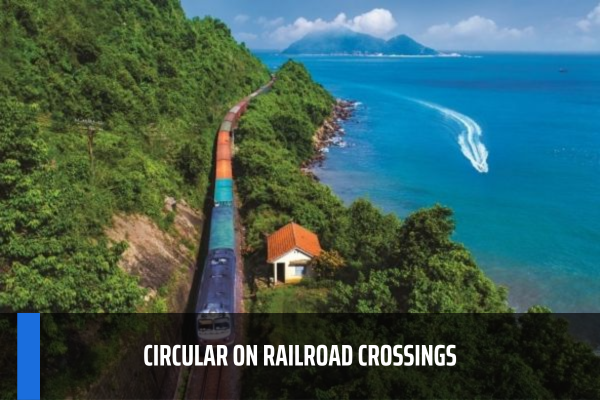To issue a Circular on railroad crossings and construction license for essential structures on railroad ground in Vietnam?
- To issue a Circular on railroad crossings and construction license for essential structures on railroad ground in Vietnam?
- What are the regulations on the radius and area of railroad crossing in Vietnam?
- What are the classification of railroad crossings in Vietnam?
- What are the requirements of railway in radius of railroad crossings in Vietnam?
To issue a Circular on railroad crossings and construction license for essential structures on railroad ground in Vietnam?
On September 29, 2023, the Minister of Transport issued Circular 29/2023/TT-BGTVT on railroad crossings and construction license for essential structures on railroad ground.
Accordingly, Circular 29/2023/TT-BGTVT regulates:
- railroad crossings; traffic at railroad crossings;
- issuance, renewal of license to build, renovate, upgrade, remove railroad crossings on national railroad, specialized railroad;
- issuance and renewal of construction license for essential structures on railroad ground.
Note: Circular 29/2023/TT-BGTVT regulating railroad crossings does not include: railroad and road on road-rail bridges; crossings between railroad and special-use road serving professional operations of stations, terminals, cargo yards, factories, industrial parks.
Subjects applying Circular 29/2023/TT-BGTVT include organizations and individuals related to:
- Construction, renovation, upgrade, destruction, management, use, and maintenance of railroad crossings.
- Traffic activities at railroad crossings.
- Construction of essential structures on railroad ground.

To issue a Circular on railroad crossings and construction license for essential structures on railroad ground in Vietnam? (Image from the Internet)
What are the regulations on the radius and area of railroad crossing in Vietnam?
In Article 4 of Circular 29/2023/TT-BGTVT, there are regulations on the radius and area of railroad crossing determined as follows:
(1) Radius of railroad crossings shall be determined as follows:
- Road segments, ground serving road traffic within railroad traffic safety corridor and separation distance of railroad structures.
- Railroad segments and railroad ground within road safety corridor.
(2) Railroad crossing area consists of:
- Radius of railroad crossing;
- Traffic safety corridor at railroad crossing according to regulations on management and protection of railroad traffic infrastructures.
What are the classification of railroad crossings in Vietnam?
In Article 5 of Circular 29/2023/TT-BGTVT, there are regulations on classification and class of railroad crossings lines as follows:
Classification and class of railroad crossings
1. Classification of railroad crossings
a) by useful life: long-term railroad crossings; limited-term railroad crossings;
b) by guard arrangement: attended railroad crossings; unattended railroad crossings;
c) by service: public railroad crossings, specialized railroad crossings.
2. Railroad crossings shall be classified into class I, class II, and class III in accordance with Appendix I hereof.
Thus, railroad crossings are classified:
Case 1: Classification by useful life:
- long-term railroad crossings;
- limited-term railroad crossings;
Case 2: Classification by guard arrangement:
- attended railroad crossings;
- unattended railroad crossings;
Case 3: Classification by service:
- public railroad crossings;
- specialized railroad crossings.
What are the requirements of railway in radius of railroad crossings in Vietnam?
In Article 7, Circular 29/2023/TT-BGTVT stipulates that railway in radius of railroad crossings must meet the following requirements:
(1) Technical requirements:
Check rail or auxiliary structures shall be required at railroad crossings so that the distance between inside of primary rail and the check rail or the auxiliary structures (hereinafter referred to as clearance) satisfies requirements below:
- Check rail or auxiliary structures creating a clearance shall extend the full width of road shoulder;
- Clearance width:
With respect to railroad cross located on straight rail or curved rail whose radius is at least 500 m: clearance width shall be 75 mm;
With respect to railroad crossings located on curved rail whose radius is less than 500 m: clearance width shall equal 75 mm + 1/2 of widening of the curved section according to National Technical Regulation on railway operation;
- Minimum clearance depth is 45 mm;
- If road section inside of the railway is made of asphalt concrete, check rail shall be required; check rail elevation shall equal to that of primary rail;
- If road section inside of the railway is made of slabs, edges of slabs that are adjacent to primary rail shall be specifically designed to form clearance;
- If check rail is installed in accordance with Point a of this Clause, both ends of the rail shall curve inwards; the length of curved ends of check rail shall be 500 mm, rail clearance at the starting position of the curved section shall conform to Point b of this Clause, rail clearance at the end position of the curved section shall be 250 mm. The starting position and end position of check rail shall be closely connected to sleepers;
- Rail connection shall not be located in the radius of railroad crossings. In case road at railroad crossing is wide, rail connection shall be welded or stretched and clipped if it cannot be welded yet;
- Rail fastening accessories shall be adequate and firmly connected.
(2) Material requirements:
- Sleepers located in railroad crossings shall be reinforced concrete sleepers; the use of metal or wooden sleepers in existing railroad crossings shall be limited; the use of metal and wooden sleepers in new built railroad crossings shall be prohibited;
- Ballast in railroad crossings shall be clean, of sufficient thickness, and up to standards as per the law;
- Materials used in installation of railroad crossings shall satisfy standards on materials used in railroad structures.
Circular 29/2023/TT-BGTVT takes effect from December 1, 2023.
LawNet